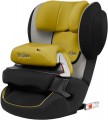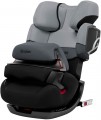Weight group
The weight of the child for which the car seat is designed.
In total, there are 5 main weight groups: 0 (0 – 10 kg; a rather rare option nowadays),
0+ (0 – 13 kg),
1 (9 – 18 kg), 2 (15 – 25 kg),
3 (22 – 36 kg). However, many car seats are produced that belong to several groups at once:
0 +/1 (0 – 18 kg),
1/2 (9 – 25 kg),
2/3 (15 – 36 kg),
0 + / 1/2 (0 – 25 kg) and even
1/2/3 (9 – 36 kg) and
0+/1/2/3 (0 – 36 kg). Such versatility affects the price, sometimes quite noticeably. On the other hand, a seat that matches several groups at once remains relevant for a child longer, and it usually costs less than two (or even more) separate products, each for a different weight category.
Note also that the weight group is directly related to age; refer to "Age range" for details.
ADAC test result
The results shown by the seat in crash tests according to the standards of ADAC — the General German Automobile Club, an authoritative European organization of motorists.
Car seats in such tests are evaluated in several categories, but in this point only one parameter is taken into account — the safety of the child, his/her protection in emergency situations. The results of such a test are indicated by the number of points; the fewer points in the end — the safer the product. It should be noted that the ADAC standards are much stricter than those by which the seat is evaluated during mandatory certification; tests are conducted with different directions of impacts (frontal and side), with dummies of different ages and so on. Therefore, the result of the ADAC test very reliably describes the real level of protection that the product provides in accidents.
According to this indicator, modern car seats can be divided into the following categories:
—
very good (< 1.5);
—
good (1.6 – 2.5);
—
satisfactory (2.6 – 3.5);
—
acceptable (3.6 – 4.5);
— unacceptable (more than 4.5).
The downside of a good value is usually a higher price; however, in an accident, that price may be a very small price to pay for the extra protection that can save your baby's life and health.
In c
...onclusion, it should be noted that ADAC test methods are constantly being improved and tests are conducted every year. Therefore, when choosing a seat and comparing it with its counterparts, you should also pay attention to the year of manufacture; as a rule, newer products with the same number of points give a higher actual level of protection than older ones.Age range
The age of the child for which the car seat is designed. Many models combine several age groups at once; such products, naturally, cost more, but remain relevant for the baby longer.
Note that this indicator is directly related to the weight group; Here are the main age ranges that are found nowadays, and the weight categories to which they correspond:
— 1 – 6 months (weight group 0); rare today.
—
1 – 12 months (weight group 0+); almost completely replaced the category "0".
—
8 – 48 months (weight group 1).
—
3 – 7 years (weight group 2).
—
6 – 12 years (weight group 3). Note that if only this weight category is indicated for the car seat, then it is a
booster: a lining without a backrest, which is placed on the standard car seat and allows the grown-up child to use "adult" seat belts. If the note "6 — 12 years" is combined with another weight category - then we have a full-fledged car seat with a backrest.
In conclusion, it is worth saying that this characteristic is not strictly defined: children of the same age may differ in development and build. So, when choosing a seat, first of all, weight should be taken into account, and then age; and if the seat corresponds to the child's height and build, there is nothing wrong with the age discrepancy.
Installation
—
Seat belt. Installation with the car seat belt. In weight groups 0, 0+ and 1, only the seat is secured in this way; the child's safety is ensured by the seat's own belts. In weight groups 2 and 3, the car belt is used to secure both the seat and the child.
—
Tor Tether. An additional harness to increase the security of fixation used in seats with Isofix and Latch systems (see below). One end of the harness is attached to the upper part of the backrest and the other end is attached to a special bracket installed in the floor of the car behind the seat or in the trunk. This reduces the likelihood of the seat being knocked over in a sudden braking or frontal impact and increases the overall safety of the small passenger.
—
Support leg. An additional attachment in the form of a support running from the bottom of the seat to the floor of the car. The purpose is similar to the Top Tether described above: it increases the safety of the seat and reduces the risk of the seat toppling when the car comes to a sudden stop. It is most often used with the Isofix system.
—
ISOFIX. The installation system for car seats in the weight category up to 18 kg is primarily found in cars from European manufacturers. The seat is secured with two locks in the rear lower part, with optional additional attachments at the top and/or b
...ottom. The design ensures foolproof installation, making it nearly impossible to install the seat incorrectly. Isofix requires the car to be equipped with suitable brackets, but even without them, these seats can usually be securely installed using the regular seat belt. However, this option may not be cost-effective, as seats with the Isofix system tend to be relatively expensive.
— LATCH. Installation system similar to Isofix. It is used mainly in American cars and, accordingly, in car seats of American manufacturers. The seat is attached at three points — two at the bottom of the seat and one at the top — so that the seat cannot be installed incorrectly. Like Isofix, seats with Latch also allow fixation with the normal car seat belt.Material
—
Polyester. Polyester is a synthetic fabric made from polyester fibers. The car seats with polyester upholstery have a pleasant to the touch surface. The material itself is not hygroscopic and is not subject to bacterial contamination. It is sufficiently resistant to mechanical stress and does not fade in the sun.
—
Microfiber. Microfiber is made from polyamides. The main feature of microfiber is the unique structure of the fabric. This material consists of numerous micropores, which explains the good ventilation of microfiber. Microfiber-based coverings have a pleasant tactile sensation. The material belongs to the category of well ventilated and breathable. Despite its synthetic origin, microfiber absorbs moisture well, but is easy to wash and dries quickly.
— Alcantara. The car seat with alcantara has an attractive appearance and excellent performance. Alcantara is an artificial suede leather, it is a very durable and practical material. It is easy to clean, does not absorb moisture and does not require any special maintenance. Alcantara is made from a mix of polyester and polyurethane fibers, as a result of complex chemical processing. It is considered one of the most prestigious materials.
—
Eco-leather. Car seats with eco-leather coverings are characterized by high practicality, reliability and durability. This material has hi
...gh wear resistance and is absolutely hypoallergenic. An important difference between eco-leather and genuine one is the thickness of the material — eco-leather is noticeably thicker, but thanks to this it has higher and strength characteristics. However, it is impossible to distinguish a good expensive eco-leather from a natural one at a glance.
— Leather. Genuine leather upholstery is characteristic of premium car seats for kids. This material looks prestigious and solid, while possessing the highest durability and wear resistance. The natural origin of the leather excludes the appearance of the child any allergic reactions to the seat. Also genuine leather is valued for the fineness of dressing, provided that the material retains high durability characteristics. In addition, it is able to absorb moisture.
— Suede. The suede covering will make your child feel comfortable and cozy. Like genuine leather, suede has good durability. This material has waterproof properties and does not require any special maintenance. Suede is obtained by chemical processing of genuine leather with subsequent tanning.
